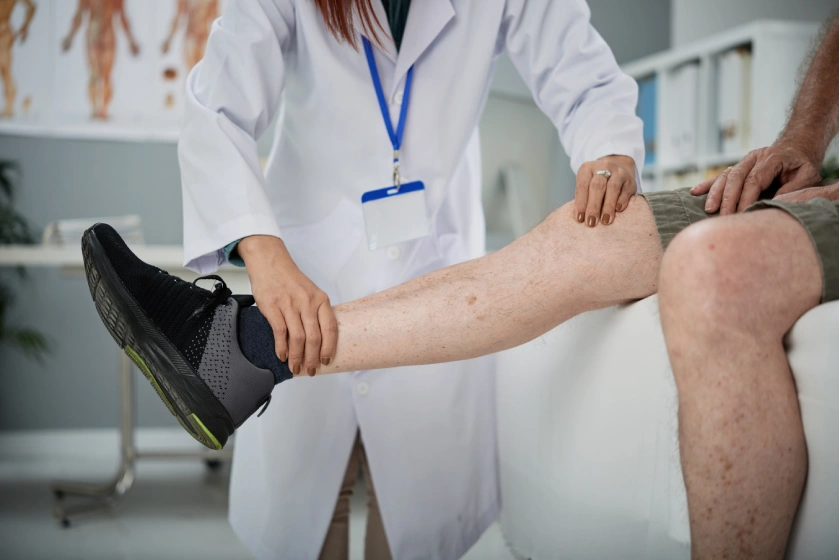
It usually happens in an instant. A young man meets with a two-wheeler accident on a busy road, walks away with just a few bruises, and assumes he is fine. But within hours, his leg starts swelling, turning cold and pale.
By the time he reaches the hospital, the damage to the blood vessels has already become severe. What appeared to be a minor external injury was, in fact, a hidden internal emergency — a case of vascular trauma.
Vascular trauma is one of the most underestimated consequences of road traffic accidents, falls, and industrial injuries.
According to Indian trauma care data, over 5% of all serious accident victims suffer from vascular injuries, and among these, limb injuries form the majority. Unfortunately, many cases go undiagnosed in the early stages simply because the signs are subtle and not widely known.
Recognizing early vascular trauma signs can make the difference between life, limb, and loss. This blog explores how to spot the red flags, understand the risks, and know when to seek immediate medical help.
What is Vascular Trauma?
Vascular trauma refers to any damage to the body’s arteries or veins that disrupts normal blood flow. This can occur due to blunt trauma, such as from road accidents, falls, or crush injuries, or due to penetrating trauma like stab wounds or gunshots. Even fractures or dislocations near major arteries can tear or compress the vessels and cut off circulation.
When blood vessels are injured, two things can happen: there may be bleeding, which is visible, or blockage (thrombosis), which is not visible but equally dangerous. The blood supply to the area beyond the injury is compromised, depriving tissues of oxygen and nutrients. If left untreated, this can result in tissue death(gangrene), permanent disability, or even amputation.
In India, vascular trauma is most often seen in the limbs, especially after road accidents, but it can also occur in the neck, chest, or abdomen. Early diagnosis and timely vascular trauma treatment are essential to prevent irreversible complications.
Why Spotting It Early Is Important
Every minute counts in vascular trauma. After a vessel is injured, the body’s tissues start losing oxygen almost immediately. Within 4 to 6 hours, the damage can become permanent. If blood flow is not restored, it may lead to gangrene, organ failure, or, in extreme cases, death.
Unfortunately, vascular trauma is often missed because its symptoms mimic other conditions. A swollen leg after an accident might be mistaken for a fracture, or a pale limb may be attributed to shock. But these could actually be signs that blood is not reaching the tissues properly.
Spotting vascular trauma symptoms early ensures immediate medical intervention. Quick diagnosis allows surgeons to perform timely vascular trauma surgery, restoring circulation and saving the limb. Delay, even by a few hours, can make a huge difference in the outcome.
A study conducted in tertiary care hospitals in India revealed that patients who arrived within six hours of injury had a 90% limb salvage rate, compared to less than 50% for those who arrived later. This highlights how crucial early recognition truly is.
Major Warning Signs
Vascular trauma does not always announce itself with dramatic bleeding. Sometimes, it presents in quiet but deadly ways. Doctors classify the warning signs into two groups — hard signs and soft signs.
Hard Signs (Emergency Indicators)
These are unmistakable and demand immediate surgical attention.
Active bleeding that spurts or pulsates in rhythm with the heartbeat
Rapidly expanding swelling or lump near the injury site.
Absence of a pulse below the site of trauma
Cold, pale, or bluish limb indicating loss of circulation
Severe pain, numbness, or inability to move the limb
Audible whooshing sound or vibration over the wound (bruit or thrill)
If any of these signs are present, the injury is almost certainly vascular and needs urgent intervention.
Soft Signs (Early Clues)
Soft signs may seem mild, but can evolve into severe complications if ignored.
History of heavy bleeding at the time of injury
Small or stable swelling near a major vessel
Weak or unequal pulse compared to the opposite limb.
Mild numbness or tingling sensation
Prolonged capillary refill time
Soft signs are often seen in cases where the blood vessel is only partially injured or compressed by a hematoma. However, these still carry a significant risk for vascular trauma and require prompt medical evaluation.
How do Doctors Check Vascular Trauma?
When a patient arrives at a trauma center with suspected vascular injury, doctors first perform a detailed clinical assessment. The examination focuses on color, temperature, pulse, and sensation in the affected limb. Even subtle changes can give away the presence of a vascular injury.
To confirm the diagnosis, several advanced imaging techniques are used:
Doppler Ultrasound
This quick, non-invasive test assesses blood flow and helps identify blockages or reduced circulation.
CT Angiography (CTA)
A high-resolution imaging technique that pinpoints the exact site and extent of vessel damage. CTA has become the gold standard for diagnosing vascular trauma.
Conventional Angiography or Digital Subtraction Angiography
Used when surgical intervention is planned. It helps visualize the blood flow in real time using contrast dye and X-rays.
Ankle-Brachial Index (ABI)
A simple bedside test comparing blood pressure in the arms and legs. A lower reading in the injured limb indicates possible arterial compromise.
Once diagnosed, treatment options are chosen based on the severity and location of the injury.
Minor vascular injuries may be managed through endovascular procedures such as balloon angioplasty or stent placement to restore flow. Some smaller arteries which are bleeding may be controlled by angioembolisation.
Major injuries require open vascular trauma surgery to repair or graft the damaged vessel. The repair may depend on the complexity of the injury and can range from simple sutures, patch or even using a vein graft.
In cases of massive bleeding, immediate surgical control and repair are critical to prevent blood loss and shock.
Specialized centers like a vascular trauma clinic are equipped with trained vascular surgeons, imaging technology, and emergency facilities for such cases. The goal is always to restore blood flow as quickly as possible and prevent tissue death.
Prevention and Awareness
While not every accident can be avoided, awareness can drastically reduce complications. In India, road traffic accidents account for more than 4.5 lakh injuries annually, many involving vascular damage. Simple preventive measures can help save lives.
- Always wear helmets and protective gear when riding two-wheelers.
- Use seat belts and follow traffic safety rules.
- Avoid driving under fatigue or alcohol influence.
- For industrial workers, wear proper safety equipment and follow machine safety protocols.
- In sports or physical activities, be cautious of high-impact injuries and fractures.
Equally important is knowing what to do after an injury. If bleeding is severe, apply direct pressure on the wound using a clean cloth and keep the injured limb elevated. Avoid using tight tourniquets, as they can worsen damage if not applied correctly. Seek immediate medical help instead of assuming the injury will heal on its own.
People with conditions like diabetes, hypertension, or a history of clotting disorders are at higher risk for vascular complications. Regular check-ups with a vascular specialist can help monitor circulation and prevent unnoticed vessel problems.
Public education and first-aid awareness can also go a long way in saving lives. Recognizing vascular trauma signs early allows patients to reach the right hospital in time for life-saving vascular trauma treatment.
Conclusion
Vascular trauma is an emergency that hides behind the mask of ordinary injuries. What may look like a simple bruise or swelling could actually be a warning that blood flow is disrupted. Ignoring these red flags can lead to devastating outcomes like tissue loss or amputation.
The key lies in awareness, timely diagnosis, and quick access to specialized care. Every patient with a limb injury, especially after a road accident or high-impact trauma, should be examined for possible vascular damage.
If you ever experience sudden swelling, coldness, or numbness in a limb after an injury, seek immediate help from an expert.
Dr. Sumit Kapadia, one of India’s most trusted vascular and endovascular surgeons, has years of experience managing complex trauma cases. His advanced vascular trauma clinic offers comprehensive evaluation, emergency surgery, and long-term rehabilitation to ensure patients recover completely and regain normal function.
With timely diagnosis and expert intervention, most vascular injuries can be treated successfully, saving both limbs and lives.
Frequently Asked Questions
Vascular trauma disrupts blood flow to vital tissues. If not treated quickly, it can lead to tissue death, infection, and even loss of limb or life.
Severe bleeding, swelling, absence of pulse, cold or pale skin, numbness, and severe pain are major warning signs that require immediate medical attention.
Soft signs include a weak pulse, small stable swelling near a vessel, tingling sensation, or a history of heavy bleeding. These indicate partial damage that can worsen without treatment.
Road traffic accidents, crush injuries, fractures near major joints, stab wounds, and gunshot wounds are the most common causes of vascular trauma.
Doctors assess the injury through physical examination, Doppler ultrasound, CT angiography, and angiographic imaging to identify and locate vessel damage accurately.

Dr. Sumit Kapadia
MBBS, MS, MRCS, DNB-Fellow



